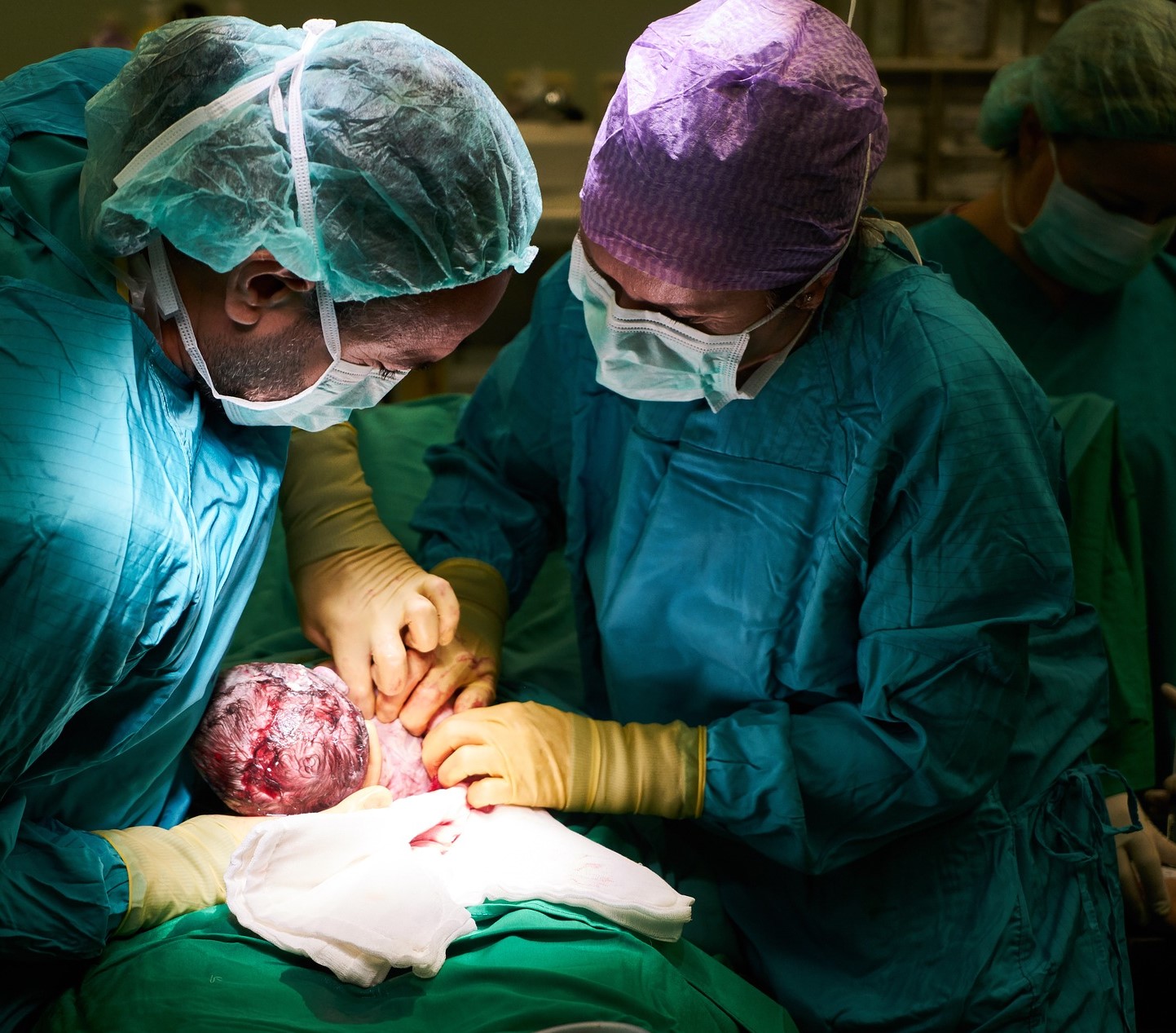Multilevel analysis of birthplace effect on the proportion of C-Section in Colombia
Abstract
Objectives:To determine the general contextual effect of the department in the variation of Cesarean section in Colombia in 2016, and their individual and contextual related factors.
Methods:A cross-sectional study based on a birth cohort. We used the birth certificate database from January 1 to December 31, 2016. Three multilevel logistic models were constructed. Pregnant women were set at the first level and department at the second level. We fitted a null multilevel model followed by two multiple models, including individual and individual and department variables, respectively.
Results:The overall prevalence of C-sections was 45.5% (95% CI: 45.4-45.6), ranged from 5 to 76%. The variance partition coefficient was 15%. Individual factors did not explain the general contextual effect. However, the region to which these departments belong explained 71% of the variance. The Caribbean region was positively associated with C-section compared to the Andean region (OR:3.88, 95% CI: 2.65-5.67).
Conclusions:Multilevel analysis of individual heterogeneity and discriminatory accuracy showed that the department plays an important role in the variation of C-sections in Colombia. Our results suggest that the proportional universalism approach should be applied to reduce the proportion of C-Section, focusing on departments with the highest risk and on the Caribbean and Insular region.
Authors
Downloads
Keywords
- caesarean section
- risk factors
- multilevel analysis
- Healthcare Disparities
- contextual effects of health disparities
References
Jones RE, Lopez KH Chapter 11 - Labor and Birth. In: Human Reproductive Biology. 4 Edición. Colorado, USA: Academic Press - Elsevier; 2014. p. 205-25. https://doi.org/10.1016/B978-0-12-382184-3.00011-8
Rubio J, Fonseca J, Buitrago M, Zuleta J, Muller E, Mendoza M, Gomez D SA. Racionalización del uso de la cesárea en Colombia . Consenso de la Federación Colombiana de Obstetricia y Ginecología ( Fecolsog ) y la Federación Colombiana de Perinatología ( Fecopen ). Rev Colomb Obstet Ginecol. 2014;65(2):139-51. https://doi.org/10.18597/rcog.62
Tita ATN, Landon MB, Spong CY, Lai Y, Leveno KJ, Varner M, et al. Timing of elective repeat cesarean delivery at term and neonatal outcomes. N Engl J Med. 2009;360(2):111-20. https://doi.org/10.1056/NEJMoa0803267
MacDorman MF, Declercq E, Menacker F, Malloy MH. Infant and neonatal mortality for primary cesarean and vaginal births to women with "no indicated risk," United States, 1998-2001 birth cohorts. Birth. 2006;33(3):175-82. https://doi.org/10.1111/j.1523-536X.2006.00102.x
Organización Mundial de la Salud. Declaración de la OMS sobre tasa de cesárea. Abril. 2015;8. https://www.who.int/es/publications/i/item/WHO-RHR-15.02#:~:text=Desde%201985%2C%20los%20profesionales%20de,como%20en%20pa%C3%ADses%20en%20desarrollo
Manrique-abril F, Amaya GMH, Matilde B, Gomez B, Cuevas OM, Arismendy VM, et al. Cesárea hoy, riesgo vs protección maternal fetal. Rev Salud Hist Sanid on-line. 2017;12(3):15-28. https://doi.org/10.5281/zenodo.4679534
Boyle A, Reddy UM. Epidemiology of cesarean delivery: the scope of the problem. Semin Perinatol. 2012;36(5):308-14. https://doi.org/10.1053/j.semperi.2012.04.012.
Boerma T, Ronsmans C, Melesse DY, Barros AJD, Barros FC, Juan L, et al. Global epidemiology of use of and disparities in caesarean sections. Lancet. 2018;392(10155):1341-8. https://doi.org/10.1016/S0140-6736(18)31928-7
Derman RJ, Althabe F, Liechty EA, Saleem S, Minckas N, Goldenberg RL, et al. An approach to identify a minimum and rational proportion of caesarean sections in resource-poor settings: a global network study. Lancet Glob Heal. 2018;6(8):e894-901 https://doi.org/10.1016/S2214-109X(18)30241-9
Departamento Administrativo Nacional de Estadísticas (DANE). Estadísticas Vitales - Eevv: Cifras Definitivas Año 2017. Vol. 2017, Dirección de Censos y Demografía. 2018. p. 1-47.
DANE. Estadísticas Vitales - Eevv: Cifras Definitivas Año 2018. Vol. 2018, Dirección de censos y demografía. 2019. p. 48.
Vecino-Ortiz AI, Bardey D, Castano-Yepes R. Hospital Variation in Cesarean Delivery: A Multilevel Analysis. Value Heal Reg Issues. 2015;(8c):116-21. https://doi.org/10.1016/j.vhri.2015.07.003
Lopez M. Mora S. Villegas A. Clasificación de las cesáreas en los grupos de robson e identificación de sus principales indicaciones, en una clinica de alta complejidad en Bogotá Colombia, 2018. Universidad Nacional de Colombia. Facultad de Medicina, departamento de Obstetricia y Ginecología; 2018. https://repositorio.unal.edu.co/bitstream/handle/unal/69278/1020775357.2019.pdf?sequence=1&isAllowed=y
Nápoles D. Piloto M. Consideraciones actuales sobre la operación cesárea. Medisan. 2012;16(10):1579.
Zuleta-Tobón JJ, Quintero-Rincón F, Quiceno-Ceballos AM. Aplicación del modelo de Robson para caracterizar la realización de cesáreas en una institución de tercer nivel de atención en Medellín, Colombia. Estudio de corte transversa. Rev Colomb Obstet Ginecol. 2013;64(2):90-9. https://doi.org/10.18597/rcog.115
Ministerio de Salud y Protección Social. Atlas de Variaciones Geográficas en Salud de Colombia 2015- Resultados de partos por cesareas. 2015;10. https://www.minsalud.gov.co/sites/rid/Lists/BibliotecaDigital/RIDE/DE/PES/Resultados-generales-atlas-salud-cesareas-2015.pdf
Hernández-Martínez A, Martínez-Galiano J, Rodríguez-Almagro J, Delgado-Rodríguez M, Gómez-Salgado J. Evidence-based Birth Attendance in Spain: Private versus Public Centers. Int J Environ Res Public Health. 2019;16(5):894. https://doi.org/10.3390/ijerph16050894
McLeroy K, Bibeau D, Steckler KGA. An_Ecological_Perspective_on_Health_Promotion_Programs. Health Educ Q, 1988; ;15(4):351-77. https://doi.org/10.1177/109019818801500401
Merlo J, Wagner P, Ghith N, Leckie G. An original stepwise multilevel logistic regression analysis of discriminatory accuracy : the case of neighbourhoods and health. PLoS ONE 11(4): e0153778, 2016 https://doi.org/10.1371/journal.pone.0153778
Merlo J, Wagner P, Leckie G. A simple multilevel approach for analysing geographical inequalities in public health reports : The case of municipality differences in obesity. Health Place. 2019;58:102145. https://doi.org/10.1016/j.healthplace.2019.102145
Caughey AB, Cahill AG, Guise JM, Rouse DJ. Safe prevention of the primary cesarean delivery This document was developed jointly by the with the assistance of. Am J Obstet Gynecol. 2014;210(3):179-93. https://doi.org/10.1016/j.ajog.2014.01.026
Merlo J. Multilevel analytical approaches in social epidemiology: Measures of health variation compared with traditional measures of association. J Epidemiol Community Health. 2003;57(8):550-2. https://doi.org/10.1136/jech.57.8.550
Merlo J, Wagner P, Austin PC, Subramanian SV, Leckie G. General and specific contextual effects in multilevel regression analyses and their paradoxical relationship: A conceptual tutorial. SSM - Popul Heal. 2018;5:33-7. https://doi.org/10.1016/j.ssmph.2018.05.006
Mulinari S, Juárez SP, Wagner P, Merlo J. Does maternal country of birth matter for understanding offspring's birthweight? A multilevel analysis of individual heterogeneity in Sweden. PLoS One. 2015;10(5):1-19 https://doi.org/10.1371/journal.pone.0129362
Marmot M. Fair Society, Healthy Lives. 126th ed. Strategic Review of Health Inequalities in England post 2010; 2010. 1-242 p.
Macdonald W, Beeston C MS. Proportionate universalism and health inequalities. NHS Health Scotland. 2014. p. 1-6. http://www.healthscotland.com/uploads/documents/24296-ProportionateUniversalismBriefing.pdf
El Departamento Administrativo Nacional de Estadísticas (DANE). Archivo Nacional de Datos Colombia - Estadísticas Vitales - EEVV 2016. . 2016;1-149. Available from: http://microdatos.dane.gov.co/index.php/catalog/519/related_materials
Departamento Administrativo Nacional de Estadísticas (DANE). Boletín departamental Producto Interno Bruto - Colombia 2016. 2017;(cited 2019 Jun 13):1-14. Available from: https://www.dane.gov.co/files/investigaciones/pib/departamentales/B_2005/Bol_dptal_2016preliminar.pdf
Departamento Administrativo Nacional de Estadística -DANE. Producto Interno Bruto (PIB) Departamental 2017. 2017. p. 1-13.
Ministerio de Salud y la Protección Social. Informe Nacional de calidad de la atención en salud 2015. MinSalud Colombia. 2015. p. 1-220. https://www.minsalud.gov.co/sites/rid/Lists/BibliotecaDigital/RIDE/DE/DIJ/informe-nal-calidad-atencion-salud-2015.pdf
Committee on Fetus and Newborn. Am Acad Pediatr. Puntuación Apgar. Pediatrics (Ed esp). 2006;61(4):270-2
Ministerio de Salud y Protección Social. Decreto número 780 de 2016 [Internet]. 2016. p. 5. Available from: https://www.minsalud.gov.co/sites/rid/Lists/BibliotecaDigital/RIDE/DE/DIJ/decreto-1990-de-2016.pdf
Maas CJM, Hox JJ. Sufficient sample sizes for multilevel modeling. Methodology. 2005;1(3):85-91. https://doi.org/10.1027/1614-2241.1.3.86
Austin PC, Leckie G. The effect of number of clusters and cluster size on statistical power and Type I error rates when testing random effects variance components in multilevel linear and logistic regression models. J Stat Comput Simul. 2018;88(16):3151-63. https://doi.org/10.1080/00949655.2018.1504945
Merlo J, Chaix B, Ohlsson H, Beckman A, Johnell K, Hjerpe P. A brief conceptual tutorial of multilevel analysis in social epidemiology: using measures of clustering in multilevel logistic regression to investigate contextual phenomena. Epidemiol Community Heal. 2006;60:290-7. https://doi.org/10.1136/jech.2004.023473
Larsen K, Merlo J. Appropriate assessment of neighborhood effects on individual health: Integrating random and fixed effects in multilevel logistic regression. Am J Epidemiol. 2005;161(1):81-8. https://doi.org/10.1093/aje/kwi252
Larsen K, Petersen JH, Budtz-Jørgensen E, Endahl E. Interpreting parameters in the logistic regression model with random effects. Biometrics. 2000;56(3):909-14. https://doi.org/10.1111/j.0006-341X.2000.00909.x
Zbiri S, Rozenberg P, Goffinet F, Milcent C. Cesarean delivery rate and staffing levels of the maternity unit. PLoS One. 2018;13(11):1-14. https://doi.org/10.1371/journal.pone.0207379
Campillo-Artero C, Serra-Burriel M. Predictive modeling of emergency cesarean delivery. PLoS One. 2018;13(1):1-14. https://doi.org/10.1371/journal.pone.0191248
DANE. Población indígena de Colombia. Resultados del censo nacional de población y vivienda 2018; . 2018;54. Available from: https://www.dane.gov.co/files/investigaciones/boletines/grupos-etnicos/presentacion-grupos-etnicos-2019.pdf
Aguirre DS. Partería y cuidado gestacional en las mujeres negras de Buenaventura como mecanismo de transmisión de saberes populares. Universidade Federal da Integração Latino-Americana. 2019. https://dspace.unila.edu.br/handle/123456789/5416;jsessionid=69253487FAA34079EC699CCA31166333
Castillo-Santana PT,Vallejo-Rodriguez ED, Cotes-Cantillo KP, Castañeda orjuela CA. Salud materna indígena en mujeres Nasa y Misak del Cauca: : tensiones, subordinación y diálogo intercultural entre dos sistemas médicos Saúde Soc 2017; 26(1): 61-74 https://doi.org/10.1590/S0104-12902017168743
Yaya S, Uthman OA, Amouzou A, Bishwajit G. Disparities in caesarean section prevalence and determinants across sub-Saharan Africa countries. Glob Heal Res Policy. 2018;3:1-9. https://doi.org/10.1186/s41256-018-0074-y
Shen M. Li L. Differences in cesarean section rates by fetal sex among Chinese women in the United States: Does Chinese culture play a role? Econ Hum Biol. 2020;36(100824):1-9. https://doi.org/10.1016/j.ehb.2019.100824
Alves da Cunha A. Sobrino TM. Gutierrez C, Alarcón VJ. Prevalencia y factores asociados a macrosomia en Perú 2013. Rev Peru Med Exp Salud Publica. 2017;34(1):36-42. https://doi.org/10.17843/rpmesp.2017.341.2765
Araujo E, Borges A, Perez AC, Elito J, Tonni G. Macrosomia. Best Pract Res Clin Obstet Gynaecol. 2017;38:83-96. https://doi.org/10.1016/j.bpobgyn.2016.08.003
Khan MN, Islam MM, Shariff AA, Alam MM, Rahman MM. Socio-demographic predictors and average annual rates of caesarean section in Bangladesh between 2004 and 2014. PLoS One. 2017;12(5):1-15. https://doi.org/10.1371/journal.pone.0177579
Alvis ZN, Alvis GN, Alvis-Zakzuk N, Edna EF, Martinez ZJ, Monterrosa CA. Frecuencia de partos por cesáreas en Cartagena, Colombia, 2006 - 2015. Value Heal. 2017;20(9):A922-3. https://doi.org/10.1016/j.jval.2017.08.3110
Muños J. Freyermuth M. Ochoa M. Factores asociados al incremento de cesáreas en México , 2011-2014. Población Salud Mesoamerica. 2020;17(2):1-32. https://doi.org/10.15517/psm.v17i2.40047
Merlo J, Wagner P, Austin PC, Subramanian SV, Leckie G. General and specific contextual effects in multilevel regression analyses and their paradoxical relationship : A conceptual tutorial. SSM Popul Health 2018; 5:33-7. https://doi.org/10.1016/j.ssmph.2018.05.006
Egan M, Kearns A, Katikireddi SV, Curl A, Lawson K, Tannahill C. Proportionate universalism in practice? A quasi-experimental study (GoWell) of a UK neighbourhood renewal programme's impact on health inequalities. Soc Sci Med J. 2016;152:41-9. https://doi.org/10.1016/j.socscimed.2016.01.026
Merlo J. Multilevel analysis of individual heterogeneity and discriminatory accuracy (MAIHDA) within an intersectional framework. Soc Sci Med. 2018;203:74-80. https://doi.org/10.1016/j.socscimed.2017.12.026

Copyright (c) 2022 Colombia Médica

This work is licensed under a Creative Commons Attribution-NonCommercial 4.0 International License.
The copy rights of the articles published in Colombia Médica belong to the Universidad del Valle. The contents of the articles that appear in the Journal are exclusively the responsibility of the authors and do not necessarily reflect the opinions of the Editorial Committee of the Journal. It is allowed to reproduce the material published in Colombia Médica without prior authorization for non-commercial use

 https://orcid.org/0000-0001-8245-0811
https://orcid.org/0000-0001-8245-0811


















